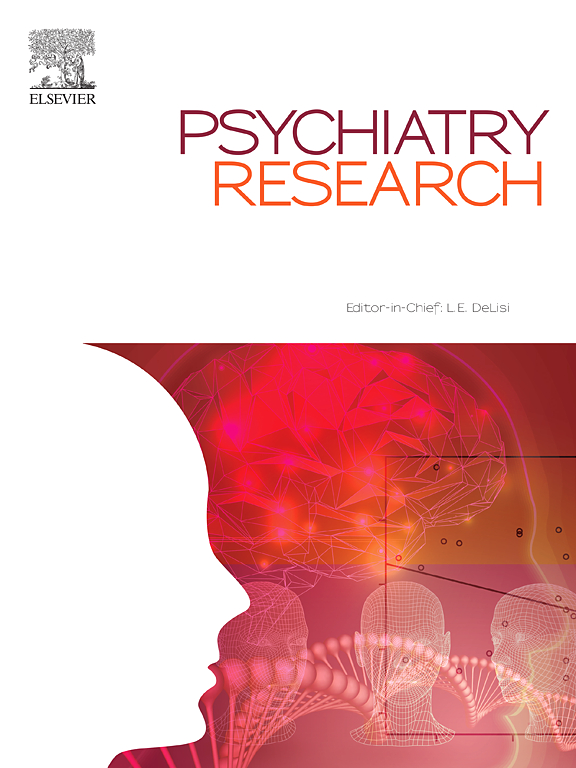精神分裂症和躁郁症患者正常面部不对称的丧失:精神病患者大脑不对称发展的影响
IF 4.2
2区 医学
Q1 PSYCHIATRY
引用次数: 0
摘要
颅骨的发育与大脑的发育在胚胎学上是密切相关的,两者都表现出正常的左右不对称。虽然面部畸形在精神病患者中发生率过高,但面部不对称作为大脑不对称的一个假定指标还有待研究。93 名受试者(49 名对照组,22 名精神分裂症患者,22 名躁郁症患者)接受了面部三维激光表面成像。通过对面部不对称统计模型的(x、y、z)可视化进行几何形态计量分析,对照组的上面部和眶周区域(与前脑在胚胎学上有密切关系)显示出明显的不对称。它们的几何特征包括:沿 x 轴,背侧和内侧向右不对称,腹侧和外侧向左不对称;沿 z 轴,腹侧和外侧向右前突。在精神分裂症和躁狂症患者中,这些正常的面部不对称都有所减弱,而在躁狂症患者中,不对称仍有残留。正常面部不对称的几何形状与正常额叶不对称的几何形状有共同之处。这些研究结果表明,精神分裂症和躁狂症都存在面部不对称的跨诊断过程。从胚胎学角度看,这些研究结果表明,面脑不对称在妊娠 7-14 周内的丧失过程涉及到以前与精神分裂症风险相关的基因。本文章由计算机程序翻译,如有差异,请以英文原文为准。
Loss of normal facial asymmetry in schizophrenia and bipolar disorder: Implications for development of brain asymmetry in psychotic illness
Development of the craniofacies occurs in embryological intimacy with development of the brain and both show normal left-right asymmetries. While facial dysmorphology occurs to excess in psychotic illness, facial asymmetry has yet to be investigated as a putative index of brain asymmetry. Ninety-three subjects (49 controls, 22 schizophrenia, 22 bipolar disorder) received 3D laser surface imaging of the face. On geometric morphometric analysis with (x, y, z) visualisations of statistical models for facial asymmetries, in controls the upper face and periorbital region, which share embryological intimacy with the forebrain, showed marked asymmetries. Their geometry included: along the x-axis, rightward asymmetry in its dorsal-medial aspects and leftward asymmetry in its ventral-lateral aspects; along the z-axis, anterior protrusion in its right ventral-lateral aspect. In both schizophrenia and bipolar disorder these normal facial asymmetries were diminished, with residual retention of asymmetries in bipolar disorder. This geometry of normal facial asymmetries shows commonalities with that of normal frontal lobe asymmetries. These findings indicate a trans-diagnostic process that involves loss of facial asymmetries in both schizophrenia and bipolar disorder. Embryologically, they implicate loss of face-brain asymmetries across gestational weeks 7–14 in processes that involve genes previously associated with risk for schizophrenia.
求助全文
通过发布文献求助,成功后即可免费获取论文全文。
去求助
来源期刊

Psychiatry Research
医学-精神病学
CiteScore
17.40
自引率
1.80%
发文量
527
审稿时长
57 days
期刊介绍:
Psychiatry Research offers swift publication of comprehensive research reports and reviews within the field of psychiatry.
The scope of the journal encompasses:
Biochemical, physiological, neuroanatomic, genetic, neurocognitive, and psychosocial determinants of psychiatric disorders.
Diagnostic assessments of psychiatric disorders.
Evaluations that pursue hypotheses about the cause or causes of psychiatric diseases.
Evaluations of pharmacologic and non-pharmacologic psychiatric treatments.
Basic neuroscience studies related to animal or neurochemical models for psychiatric disorders.
Methodological advances, such as instrumentation, clinical scales, and assays directly applicable to psychiatric research.
 求助内容:
求助内容: 应助结果提醒方式:
应助结果提醒方式:


